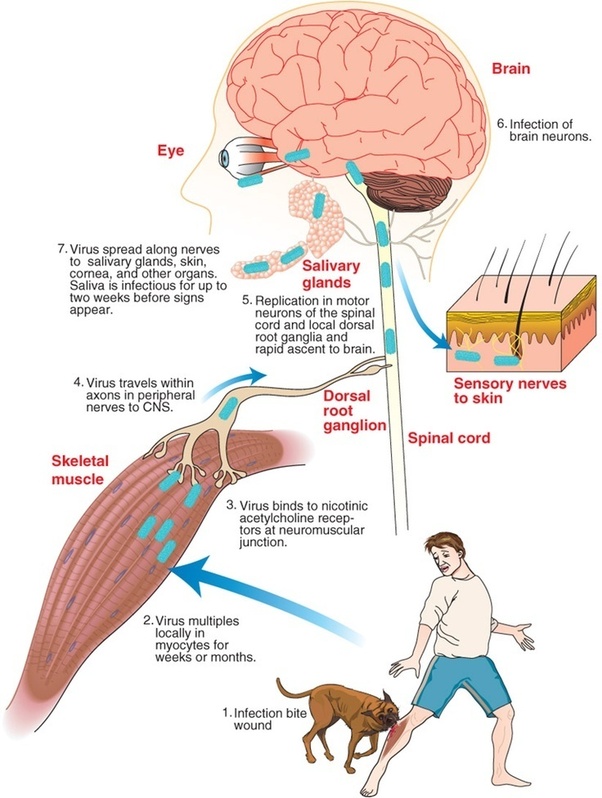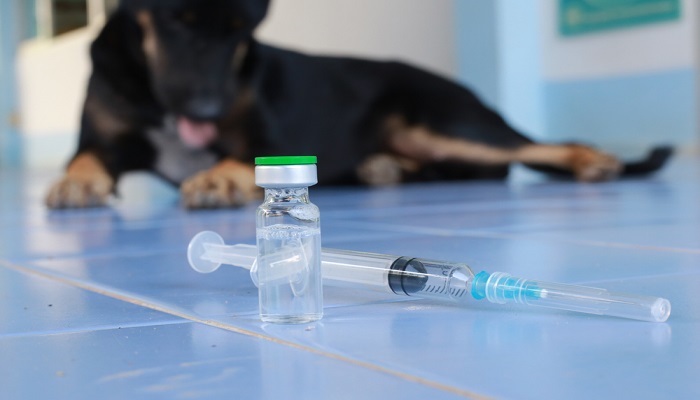Rabies is a lethal viral infection of humans. The rabies lyssavirus or commonly known, rabies virus belongs to rhabdovirus family of neurotrophic viruses. These viruses mainly attack the peripheral nervous system when enter the human body. Moreover, the virus is mostly transmitted through animal bite such as dogs, foxes, bats and raccoons etc. Moreover, the stray dogs are the most common carriers and source of rabies. The problem is more prevalent in developing countries compared to the developed ones.
Once, the person get bite of a rabid dog, the signs and sym ptoms appear in short time if not provided with medical aid. If remain untreated, this condition is nearly always fetal. Moreover, rabies is also named as hydrophobia (fear of water). The reason is that the patient experiences severe spam and convulsions as he tries to swallow something even water. Therefore, the patients are usually afraid of drinking water or swallow anything.
ptoms appear in short time if not provided with medical aid. If remain untreated, this condition is nearly always fetal. Moreover, rabies is also named as hydrophobia (fear of water). The reason is that the patient experiences severe spam and convulsions as he tries to swallow something even water. Therefore, the patients are usually afraid of drinking water or swallow anything.
Types of rabies infection
Encephalitic rabies
The major signs and symptoms of this type of rabies are hyperactivity and agitation and hydrophobia. Almost 80% if the cases are of this type.
Paralytic rabies
This type is less common and it’s mainly characterized by paralysis.
Major Signs and symptoms
The initial signs and symptoms are similar to common flu. later, the symptoms aggravate and appear as:
- Fever
- Headache and fatigue
- Nausea
- Vomiting
- Difficult swelling
- Agitation
- Confusion
- Anxiety
- Hypersalivation (excess saliva in mouth)
- Hyperactivity
- Excessive salivation
- Paralysis
- Inconsistent and heavy breathing
- Hydrophobia (fear of water)
- Hallucinations
- Convulsion and seizures
Transmission of virus
Animals are source of transmitting rabies infection. the virus in their saliva transmits to human body via bite. Moreover, if the infected animal licks an open wound, it also transmits rabies virus.

The animals which usually transmit infection are:
- Dogs
- Cats
- Horses
- Coyotes
- Bats
- Monkey
- Raccoons
- Foxes
- It is rare but virus may be transmitted via blood transfusion from infected person.
The stages of infections
- Once a person gets bite of rabid dog or some other animal, the virus transmits into the person’s body by saliva.
- Later the incubation period of virus is 3-10 weeks. However, this period can be as short as 4-5 days.
- After incubation, the signs and symptoms appear which may get worse if not treated in time.
- Bite close to brain and neck are more damaging as the virus rapidly gets to the brain.
- The aggravated symptoms are hallucinations, hydrophobia (fear of water) and coma. This is termed as acute neurological period.
- This may lead to patient’s death in a matter of hours.
Risk factors
Some factors put you at more risks of getting this lethal infection.
- Having a pet such as dog or cats
- Travelling to county where rabies is more common such as Africa and Asian countries
- Having open wounds from where you can get virus
- Working in hospital and labs with rabies virus
Treatment options
Any treatment which is provided to patient is effective if given in time, before the symptoms get worse. It is wise not to waste time in checking that the animal has rabies or not. As soon as you get a bite from pet animals, rush to the hospital to get treatment. If this takes time, you should wash the wound with an antiseptic soap or sanitizer. This will prevent the virus entry to body to some extent.

The treatment for this infection involves a fast acting immune-globulin vaccine shot. Moreover, there are preventive vaccines available for this infection. The vaccines ‘teach and train ‘your immune system to fight the rabies virus effectively by developing specific antibodies.
Preventive measures
It’s always wise to take preventive steps to prevent any chances of getting this viral infection. You should:
- Vaccinate your pets
- Keep your pets under supervision and confined so as to prevent their contact with wild animals
- Do consider a rabies vaccine shot if you are travelling to countries with higher incidences of rabies.
Take some notes
Rabies is a deadly viral infection. A little bit of precautions and in time medical aid is helpful to survive this viral infection. Therefore, it’s wise to be aware about such infections and what you should do in such circumstances.

